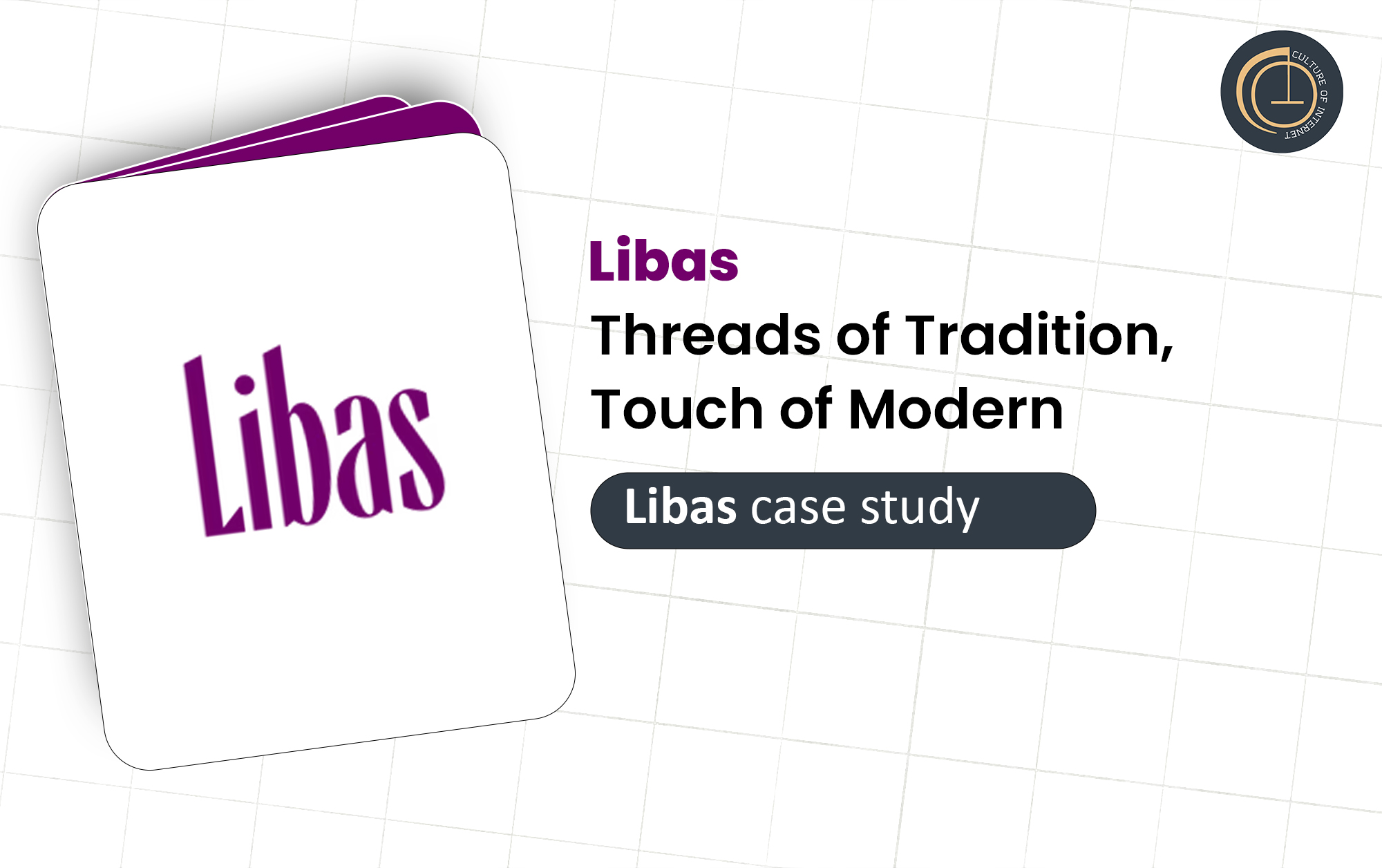Libas: Company Overview
The Beginning of Elegance: The Libas Origin Story
Libas, a prominent Indian ethnic wear brand, started in 1985 with a focus on women's ethnic wear. The company, initially established by Sunil Keshwani, expanded its online presence in 2013 under the leadership of Sidhant Keshwani. Libas gained significant traction by launching on e-commerce platforms like Myntra and Flipkart in 2014 and later established its own website in 2019, becoming a direct-to-consumer (D2C) brand. Libas also expanded into offline retail with standalone stores and multi-brand outlets, and introduced sub-brands like Libas Extra Love (plus-size) and Libas Art (premium occasion wear)
Where Do Libas Stand Today?"
Libas, an Indian fast-fashion brand, is currently a prominent player in the ethnic wear market, focusing on an omnichannel strategy with a strong online presence and expanding physical stores. They are known for their trendy, ready-to-wear ethnic wear like kurtas, suits, sarees, and lehengas, and are also venturing into fusion wear. Libas has recently raised external funding to further strengthen its omni-channel strategy and capitalize on the growing demand for fusion wear.
-
Omnichannel Presence: Libas has a strong online presence through its website Libas and various e-commerce platforms like Myntra, Flipkart, and Amazon. They also have a growing network of physical stores, including a flagship bridal store in Lajpat Nagar.
-
Focus on Trends: The company emphasizes keeping up with current fashion trends, particularly in the fast-fashion space, and updating its collections accordingly.
-
Funding and Growth: Libas has secured external funding to support its expansion plans and to further develop its online and offline presence.
-
Competition: Libas operates in a competitive market with other notable brands like Shree, Dhaaga, and Maaesa Clothing, among others according to CB Insights. Customer
-
Focus: Libas emphasizes customer satisfaction and aims to build long-term relationships by providing a wide range of stylish and affordable clothing. Bridal Wear: The recent launch of their flagship bridal store in Lajpat Nagar indicates a strategic move to cater to the bridal wear market, which is a significant segment within ethnic wear.
How Is Libas Expanding Its Fashion Network?
Libas is expanding its fashion network through a multi-pronged approach focused on both online and offline channels. They are rapidly increasing their physical store presence, enhancing their online e-commerce experience, and leveraging partnerships for quicker deliveries.
-
Offline Expansion:
-
Exclusive Brand Outlets (EBOs): Libas plans to open 100 EBOs by the end of fiscal year 2026, starting with metro cities and then expanding to state capitals.
-
Store Openings: They recently opened stores in Lucknow, New Delhi, and Pune, adding 9,000 square feet of retail space.
-
Multi-Brand Outlets (MBOs): Libas is also present in over 500 MBOs, including major retailers like Shoppers Stop, Lifestyle, and Reliance Trends.
-
Franchise Model: While currently company-owned and operated, Libas is exploring a franchise model for future expansion.
-
Store Design: New stores feature a blend of modern and traditional elements, with dedicated sections for different product categories.
-
-
Online Expansion:
-
E-commerce Growth: Libas is focusing on strengthening its direct-to-consumer (D2C) channel and overall online presence.
-
Quick Commerce: They partnered with Zepto for 10-12 minute deliveries in over 50 cities, aiming for instant access to fashion.
-
Myntra's M-Now: Libas debuted on Myntra's M-Now service for faster delivery options.
-
How Do Partnerships Power Libas’ Growth?"
Strategic partnerships play a vital role in powering Libas' growth by enabling access to new markets, shared resources, and collaborative problem-solving, leading to accelerated success. These alliances allow Libas to leverage the strengths of its partners, fostering innovation and expanding its reach. By embracing collaboration, Libas can tap into new customer segments, access additional resources, and create mutually beneficial opportunities for growth.
What do numbers say about libas ?
Libas, a direct-to-consumer (D2C) ethnic wear brand, has seen significant revenue growth and expansion in recent years. In FY24, the company's revenue from operations reached ₹487 crore, a 38% increase from ₹352 crore in the previous fiscal year. Libas is also expanding its omnichannel presence, aiming to have 100 exclusive brand outlets (EBOs) by the end of FY26.
-
Revenue: Libas' revenue for FY24 was ₹487 crore, a substantial increase from ₹352 crore in FY23.
-
Revenue Growth: The company experienced a 38% year-over-year revenue growth.
-
Fundraising: Libas successfully raised ₹150 crore from ICICI Ventures.
-
EBO Expansion: The brand currently operates 18 EBOs and is targeting 100 by the end of FY26.
-
Store Presence: Libas products are available in major e-commerce platforms like Myntra, Flipkart, and Amazon, as well as in physical stores like Lifestyle, Trends, and Central.
-
Warehouses: The company has a 1.5 lakh sq. ft. mother warehouse in Noida and additional warehouses in Bangalore, Bhiwandi, Kolkata, and Gurgaon.
What are the problems faced by libas?
Libas has faced several challenges, including high material and advertising costs, leading to a significant decline in profits. They also experienced issues with order management, particularly during the pandemic, when they relied heavily on WhatsApp for order processing, leading to stock and tracking problems. Furthermore, Libas has faced challenges with logistics, including high shipping costs and issues with returns and non-delivered orders.
-
Financial:
-
High Material Costs: Material costs constitute a significant portion of Libas's expenses, rising 41% to Rs 296 crore in FY24.
-
Increased Advertising Expenses: Advertising costs surged by 121% to Rs 42 crore in FY24.
-
Declining Profits: The combination of increased costs led to a 64% drop in profit in FY24.
-
Cash Flow Issues: Libas faces a cash imbalance due to differing payment cycles with suppliers and the need to pay tailors on delivery.
-
-
Operational:
-
Order Management Issues: Relying on manual order processing via WhatsApp during the pandemic highlighted the need for a more robust system.
-
Logistics Problems: High shipping costs, especially with heavier packages, and challenges with returns and non-delivery impact profitability and customer satisfaction.
-
-
Other Challenges:
-
Competitive Market: The women's ethnic wear market is highly competitive, requiring Libas to constantly innovate and adapt.
-
Customer Expectations: Meeting the demands for free and fast shipping, as well as addressing product quality issues, is crucial for customer retention.
-
Omnichannel Expansion: While Libas is expanding its offline presence, managing both online and offline channels effectively is a challenge.
-
What were its effective solutions?
Libas implemented several effective solutions to achieve growth and enhance customer experience. These include a strong focus on supply chain management, leveraging technology for efficient operations, and building a robust omnichannel presence. Additionally, they focused on building customer trust through quality products, affordability, and a seamless shopping experience.
Here's a more detailed breakdown:
-
1. Supply Chain Management:
-
Libas has an efficient supply chain that connects manufacturers, suppliers, designers, and warehouse staff.
-
This allows them to maintain a balanced product cycle, from procurement to delivery, within 5-7 days, while managing inventory and minimizing damages.
-
They focus on local sourcing to optimize production costs and maintain quality control.
-
-
2. Technology Adoption:
-
Libas uses technology to optimize and automate processes, identify risks, and monitor system performance.
-
They leverage technology for supply chain and direct-to-consumer (D2C) operations.
-
They are also exploring technology to reduce turnaround time for introducing new trends.
-
Libas also uses technology like Shipway's AI-based courier allocation system and real-time tracking to optimize delivery and reduce costs.
-
What was the Founders’ Perspective?
The founders of Libas, Sidhant and Riyaz Gangji, envisioned a brand that would modernize Indian ethnic wear, making it fashionable, trendy, and relevant for everyday wear. They aimed to bridge the gap between traditional Indian clothing and contemporary style, offering designs that embrace India's cultural heritage while appealing to a modern sensibility. They saw an opportunity to make Indian wear as appealing and accessible as Western wear, particularly for younger generations.
What are the Marketing strategies used by Libas ?
Libas employs a multi-faceted marketing strategy that includes a strong online presence, particularly on social media and e-commerce platforms, along with strategic partnerships and offline retail expansion. They focus on building brand awareness through influencer marketing, user-generated content, and engaging social media campaigns. They also utilize a mix of paid and organic marketing, including social media events, giveaways, and interactive sessions.
-
Digital Marketing:
-
E-commerce Dominance: Libas leverages its own website and popular marketplaces like Myntra and Flipkart to reach a wide customer base.
-
Social Media Marketing: They are active on platforms like Instagram, Facebook, and YouTube, using them to showcase products, engage with customers, and run targeted ad campaigns.
-
Influencer Marketing: Collaborations with influencers and brand ambassadors amplify their reach and create buzz around their products and campaigns.
-
Content Marketing: Libas uses blog posts and other content to enhance their brand visibility and target relevant keywords for search engine optimization.
-
SEO: They focus on optimizing their website and content for search engines to drive organic traffic.
-
Live Shopping: They utilize live shopping events to boost buyer engagement and sales.
-
Conclusion
Libas, a prominent Indian ethnic wear brand, has demonstrated significant growth and success through a strategic focus on omnichannel expansion, leveraging both e-commerce and offline retail. The brand is known for its diverse range of fashionable and affordable collections, catering to various occasions and festivities. With a strong online presence and a growing network of physical stores, Libas is well-positioned for future growth in the Indian fashion market.
Explore Our Comprehensive Marketing Strategy Course
Join our in-depth course to master Libas India's marketing strategies, learn from expert case studies, and gain actionable insights to apply in your own business or career.









